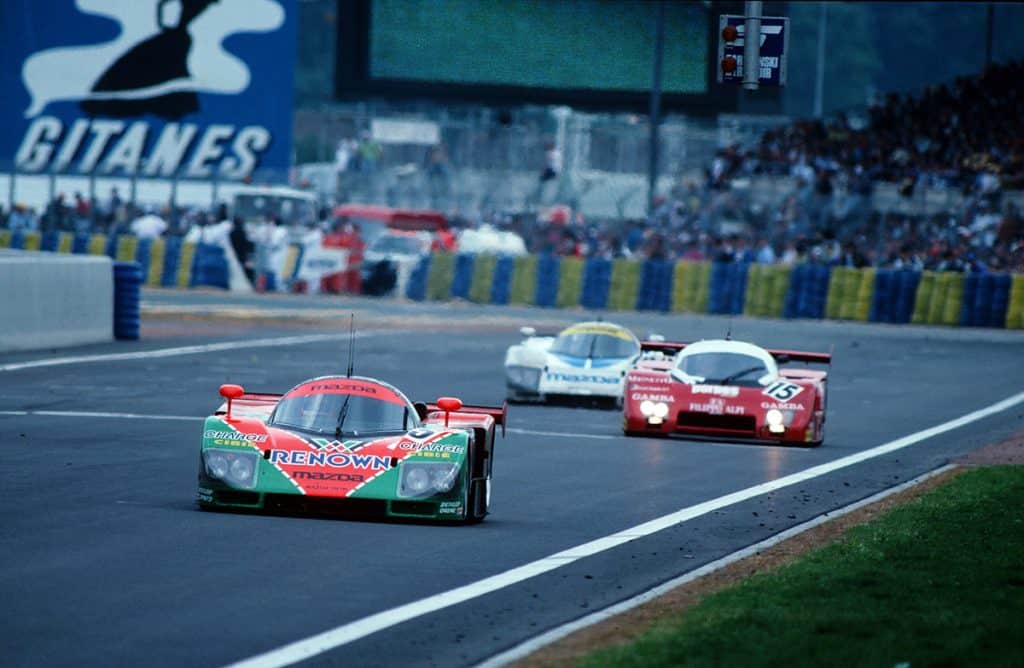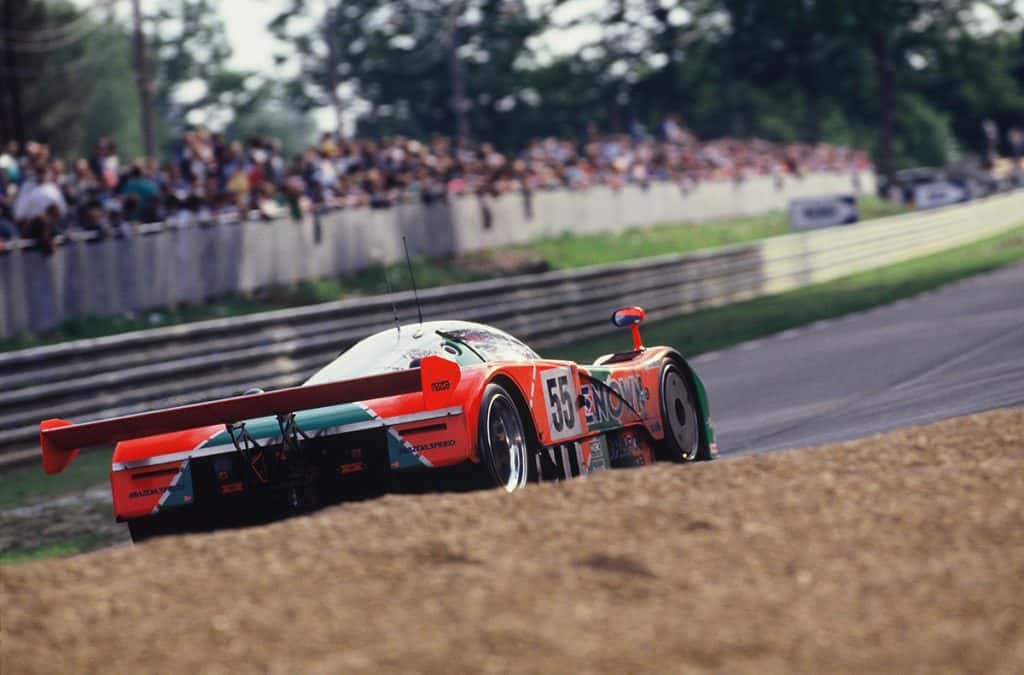It was the 9,000-rpm scream heard around the world—and the ground shook with the reverberations of the very significance of that roar. A Japanese car company has won the 24 Hours of Le Mans, long the stronghold of European marques. The date was June 23, 1991.
In the past, Le Mans was the stage for legendary battles between Ferrari and Ford in the 60s, the success of France’s Alpine in the 70s, the rise of Porsche, Mercedes, Jaguar, and Peugeot in the 80s, 90s, and through the 2000’s, and the era of Audi, which won a series of races with its diesel-powered hybrid cars.
On June 23 this year, 30 years have passed since the now-iconic orange-and-green Mazda 787B took overall victory at Le Mans. That Mazda 787B—chassis no. 002—is fully functional and on permanent display at the Mazda Museum in Hiroshima. It has become one of the world’s most recognizable and beloved racecars of all time.
The road to Le Mans
Mazda’s journey to the top step of the podium wasn’t an easy one. Mazda’s Le Mans Challenge dates back to 1974. At the time, Mazda Auto Tokyo Motorsports Division, which was competing in the Fuji Grand Champion Series and Fuji Touring Car Series, decided to challenge the 24 Hours of Le Mans. However the team was let down by various problems and failed to finish the race. Mazda Auto Tokyo, which had turned the first RX-7 into a Le Mans car, received support from Mazda, and in 1983 became independent as Mazdaspeed Corporation.

In 1984, Mazda abandoned the idea of turbocharging the rotary engine and pursued multi-rotor engines for more power. In 1987, Mazda became the first Japanese car to finish seventh overall in Le Mans. Meanwhile, the FIA (Fédération Internationale de l’Automobile) and FISA (Fédération Internationale du Sport Automobile), the organizers of Le Mans, rewrote the rules from scratch, announcing in 1989 a new regulation banning rotary engine cars from competing in the World Sports Prototype Endurance Championship (WSPC), of which Le Mans is the centerpiece race.
The Mazda Le Mans cars that had evolved step by step up to that point were based on the unique rotary engine technology, and the fact that the rotary engines could no longer run at Le Mans was a huge blow to the Mazda team. Mazda’s management knew this and issued a major decree to “build a car that can win at Le Mans.” As a result, in 1989, Mazda achieved a significant improvement in performance. But despite that, the best their three cars could achieve was 7th, 9th, and 12th place.
Fortunately, other manufacturers were unable to develop vehicles in time to meet the new regulations, and the new regulations would not be implemented until 1991, before which time it was also announced that rotary engine cars could still run that year.
Mazda and Mazdaspeed once again scrutinized their “winning scenario.” For the following year, they developed an improved Mazda 787B that incorporated further improvements to the engine and new technologies, such as carbon brakes, and headed to Le Mans in 1991, after completing a 24-hour simulation test at the Paul Ricard Circuit and fully ensuring its durability. In the final year of the rotary engine, the 700ps Mazda 787B became the first Japanese car ever to win Le Mans.

It was a dramatic and convincing win, too. The victorious car no.55 moved up to the race lead right from the beginning, overtaking the Jaguars and Mercedes racecars—with one of the Mercedes racecars driven by one young Michael Schumacher. The other two Mazda 787Bs also finished in the top ten.
Rotary genius
No discussion of Mazda’s Le Mans win would be complete without a look at its mighty yet surprisingly small engine. Displacing a svelte 2.6 liters with its naturally aspirated four-rotor design, Mazda’s Le Mans-conquering R26B rotary engine had been redesigned from the previous year’s Le Mans campaign with new materials, weight reduction and increased rigidity, a three-plug ignition system, and a multi-stage variable air intake system—enough for it to develop 700ps at 9,000 rpm and 608Nm of torque at 6,500 rpm. In addition, a precise simulation of the 13.6-km circuit of Le Mans was used to control the fuel cutoff when the throttle was turned off to improve fuel efficiency. The variable air intake system used a new stepless linear variability to expand the torque range. This engine ran smoothly, effortlessly, and with nary a hiccup throughout its 24-hour stint at or near the 9,000-rpm redline.
A classy chassis
The Mazda 787B is based on the 1986 Mazda 757, for which British race car designer Nigel Stroud was in charge of basic design, and is the culmination of a series of design changes made by Mazdaspeed’s design group to optimize the rotary-powered racecar, modifying each part of the car to match the change in power unit from a three-rotor engine to a four-rotor one.

The cockpit is a twin-tube monocoque, employing light yet strong carbon composite materials laminated together and heat-treated in a special kiln. Since Mazda/Mazdaspeed did not have a gearbox specifically designed for a rotary engine, the five-speed gearbox from the Porsche 962C was used as the transmission mechanism from the 757 through 787 racecars. The gearbox was located behind the bellhousing, allowing gear ratio changes and maintenance to be carried out with the gearbox still in the car.
“Never stop challenging”
Mazda hopes to share the spirit of “never stop challenging” that it has cultivated through its real-life motorsports activities, with a wider range of customers in the digital motorsports world, a realm which has become increasingly popular in recent years.

The Mazda 787B continues to be loved by many fans to this day. In 2011, 20 years after the victory, the car received an invitation from the ACO (Automobile Club de l’Ouest), the organizer of the 24 Hours of Le Mans. After several months spent completely restoring the Mazda 787B, it appeared at Circuit de la Sarthe for the first time in 20 years and carried out a demonstration run in front of a huge crowd. Two years later, at the 90th anniversary of the 24 Hours of Le Mans, held at the same location, the car was voted the most popular car of the 1990s by a worldwide online vote, and again participated in a parade run.
As for Japanese cars, the Mazda 787B’s win in 1991 will not be repeated for 17 years, until 2018, when Toyota won its first of three consecutive Le Mans races.

